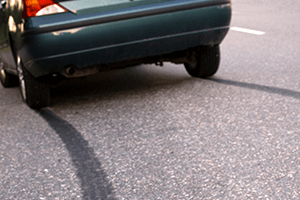1. Introduction to young & first time drivers
Around 1.6 million Brits take their practical driving test annually, and although there's only a pass rate of roughly 43%, there are still close to 700,000 new drivers on the roads each year. The driving test itself is designed to challenge the learner and ensure they're well prepared for a life behind the wheel.
However, when all the hard work and preparation finally pays off, young drivers are often left not knowing what to do after that all important pass has been achieved. This resource has been created in an effort to not only help prepare young drivers for their theory and practical, but provide extensive information on key elements to their motoring future.
Facts & figures regarding young drivers in the UK
It's not surprising when looking at the statistics that young drivers are most likely to have an accident on the road. Typically, this concerns drivers aged between 17 and 24 and because of the statistics, the insurance bracket for this demographic tends to be most expensive.
In fact, the most worrying number is that 17-19 year-olds make up just 1.5% of UK driving licence holders, but are involved in 12% of serious and fatal incidents on the road.
- 16-19 year olds are more than twice as likely to be killed in a road collision than 40-49 year-olds.
- 23% of 18-24 year olds will be involved in a road collision within two years of passing their practical test.
- Young male drivers are most at risk of being involved in a road collision.
There are many reasons why youngsters are most at risk from road accidents, but experts often point to youth and inexperience as the contributing factors. Essentially, there's a problem with young motorists not only taking more risks on the road, but not having the experience to spot hazards and avoid incidents. As the motorist ages, their road perception drastically improves.
Characteristics associated with younger motorists include:

Overconfidence:
When passing their driving test it's easy for youngsters to quickly feel they've mastered this particular skill. The truth is though, it takes years of experience driving in all conditions and environments to get a firm grip on driving. New drivers will take more risks due to a perceived overconfidence and are therefore, more likely to be involved in a road collision.

Poor hazard perception:
Whilst the British theory test may include hazard perception, this won't fully equip drivers for the real world. On top of this, during the 40 hours or so of lessons a student builds up, they wouldn't have encountered all situations. It takes an experienced motorist to spot the real dangers of the road and take action to avoid an incident. The inexperience of hazard perception results in an increased likelihood of collision.

High risk taking:
This has been mentioned previously, but younger motorists are much more likely to take risks on the road and as such, be responsible for a road accident. Some of the risky manoeuvres younger motorists may attempt on the road include blind overtakes, excessive speeding, not wearing seat belts and even driving under the influence.
The UK theory & practical driving tests
With the above dangers associated with young drivers, why isn't this stamped out during the learning phase? The UK driving test is designed to teach students the fundamentals of road safety and ensure they're well equipped to act responsibly. However, once the test has been passed there are seemingly no restrictions. It is hoped youngsters will instead put everything they've learned into practice.
The driving test itself is split into two parts; the theory and practical. Either test can be taken after your 17th birthday, but you must have passed the theory to then take the practical stage. There's plenty of literature and advice available to help you with both parts of the test, namely the Highway Code.

The theory test
The theory test needs to be passed before undertaking the practical and pass rates tend to be high. You won't need to get into a vehicle for this part of the examination and instead will simply work from a test centre computer.
There are two aspects to the theory test; a multiple choice and a hazard perception section. You must pass both to successfully complete the theory test and failing either will result in you needing to book another date in your diary for a resit.
Fortunately, there's plenty available online in the form of practice tests and information. Therefore, you should be well prepared for both sections, with little in the way of surprises.
Section one is the multiple choice stage. There are 50 questions to answer, with four possible options. The questions will typically be taken from information in the Highway Code.
You'll be given 57 minutes to take this stage of the test and must score at least 43 out of 50 to pass.
Section two is the hazard perception test. You are entitled to a three-minute break between the two tests if required.
Before sitting the hazard perception stage you'll be able to view an introductory video as a way of understanding what you're about to undertake. In total there are 14 video clips to watch and your job is to click your mouse every time you witness a potential hazard. The earlier you click, the better score you'll receive.
There are penalties for clicking too often and trying to 'cheat' the system, so ensure to only click when you spot a potential hazard on the road.
Each hazard is scored out of five and in total you'll need 44/75 to pass the perception test.

The practical test
You should only undertake the practical part of the driving test after completing a sufficient number of lessons on the road in all situations. Ideally, your instructor would recommend when you're ready to take the test. Not only would you be disappointed for failing if ill-prepared, but the test is also expensive.
There are a number of questions you can ask to determine whether you're ready to take the practical stage of your driving test:
- Are you competent at all road manoeuvres, including bay and parallel parking, reversing round a corner and three-point turns?
- Can you drive without prompts or interference from your instructor?
- Has your driving instructor recommended it wise to take your practical?
- Are you able to read a number plate from 20.5 metres? Remember, you may need to bring glasses to the centre
- Have you thoroughly revised the 'show me tell me' section of the practical?
- Have you completed your theory test?
There's typically a long waiting list for students wishing to take their practical and as such, instructors will often suggest booking in advance, when they believe the pupil will be exam ready.
On the day of your practical...
Your instructor will likely pick you up an hour or so before the test is due to commence. This will give you time to ‘warm-up' and put you in the right frame of mind for driving. The instructor will also help remind you of some of the key elements in the test such as 'show me tell me'.
What you need to bring...
On the day you're set for your practical test, make sure to bring with you:
- The photo card part of your driving license
- Your theory test certificate
- Glasses, if required
- Proof that your vehicle is taxed and insured, if you'll be driving your own car.
Before starting the test...
Before the actual driving test itself, the examiner will want to check your eyesight. You'll therefore be required to read a number plate from 20.5 metres. Remember to bring glasses if you need them. You'll also run through the 'show me tell me', which includes showcasing your knowledge of the vehicle, such as where the engine oil, water and screen wash is topped up etc.
The examiner will then explain how the test will work and what is required from you. They'll likely tell you the route you'll be taking during the 40-45-minute session.
During the driving test...
The driving test will be roughly 40-45 minutes in total and during which you'll be required to travel on various roads at varying speeds. You'll also need to complete at least one manoeuvre, so make sure you're well versed in all of these.
Throughout the test, the examiner will mark your ability to drive and carry out manoeuvres you're asked to undertake. You'll receive minor and major faults, depending on any errors made. If you receive a major you'll automatically fail, whereas you can receive up to 15 minors.
When you return to the centre, the examiner will tell you whether you have passed or failed, and point out where minors or majors have been attributed.
10 tips to help you pass your driving test
The day of your driving test can be extremely nerve wracking. This is a huge event after all and you've spent countless hours learning and refining your skills. Over a course of 40-odd minutes your driving will be scrutinised and every mistake jotted down. What you need to do is be in the right frame of mind for the test. This is probably easier said than done, but by stepping into the driver's seat with confidence you'll have better odds of passing. Here are 10 great tips to help you better prepare and put those nerves to bed on the day of your practical:
-
1. Lots of practice:
This means spending more time on the road, refining your skills and building confidence up over a long period of time. Whilst there are crash courses available, whereby centres promise passes within just two weeks, this isn't enough time to truly have a complete appreciation of the road. Get more time behind the wheel and you'll in turn have more confidence for the test. -
2. Learn the test routes:
Although test centres will look to deny it, many actually use the same few test routes for each exam. Why? Because they've been driven countless times and offer a number of different, challenging scenarios for the learner. Find out where your likely routes will take you and spend time practicing them to avoid any surprises. -
3. Practice manoeuvres:
The manoeuvres are an integral part of your practical test and as such, you need to ensure you've fully prepared for these and can confidently perform each when asked. -
4. Don't forget the theory:
You may already have taken and passed your theory test, but now isn't the time to leave all this knowledge behind. Revisit your theory and make sure to read up on the information - you never know when it may be useful. -
5. Try to relax:
This is easier said than done, but on your test it's important to try and remain calm, avoid panicking and above all relax. You're obviously ready for this exam or you wouldn't be in this position, so remember everything you've learned and apply it. Even if you think you've made a mistake on the test, it may not be worthy of a fail, so put it to the back of your mind and focus on avoiding any further errors. -
6. Know your car:
The 'show me tell me' section can bamboozle some, so make sure you're not failing at the first hurdle. Spend time under the bonnet, inspecting the car and knowing exactly what everything does. This can be with your instructor or even your parents. -
7. Drive in all conditions:
You can't predict what the weather will bring on the day of your test. Therefore, you should try to arrange lessons in all manner of weather, to ensure you're not left panicking on the day. -
8. Get a good meal:
Not eating before your test will only make the nerves worse. Try to get a good meal in beforehand and this will instantly aid in putting away those dreaded nerves. There are also toilets in the centre, so make sure you stay refreshed. -
9. Don't be afraid to talk:
This isn't like a school exam, you are allowed to talk for the duration. Some learners will deliberately avoid speaking in an effort to better focus on the road, but don't be afraid to ask your examiner a question if you don't hear something they've said first time. -
10. Don't give up:
This has been touched upon in another point, but no matter how you feel your test is going, don't give up thinking yourself to have failed already. Carry on with the confidence you started with and you never know, perhaps the mistake you made wasn't as dramatic as you first thought. Your examiner has the final say after all.
The toughest & easiest places to pass your driving test
Driving tests have been around for some 80 years now and since the government first brought them into law, there has been a stigma of areas of the country being easier to pass in than others. But is there really a case for this? Driving instructors and examiners are all assessed by the same organisation, the Driving and Vehicle Standards Agency (DVSA), so does that mean you have the same odds of passing wherever you reside in the country?
Well, as you'll see from the tables below there is quite a contrast between the most and least successful areas for pass rates. For instance, whilst the average pass rate from 2013/14 was 47.1%, success in Belvedere was 15% less than this. Compare that to the Isle of Mull, which has an extremely high pass rate of 80%.
| Isle of Mull | 80 |
| Barra | 77.8 |
| Brodick | 73.1 |
| Isle of Skye | 72.2 |
| Ballachulish | 71.4 |
| Kendal | 70.8 |
| Ballater | 69.8 |
| Barrow in Furness | 68.3 |
| Mallaig | 68.2 |
| Llandrindod Wells | 68.1 |
| Belvedere (London) | 32.2 |
| South Yardley (Birmingham) | 32.4 |
| Barking (London) | 33.3 |
| Wednesbury | 33.4 |
| Wanstead (London) | 33.5 |
| Wood Green (London) | 34.2 |
| Kingstanding (Birmingham) | 35.1 |
| Leeds | 36.3 |
| Enfield (London) | 36.4 |
| Luton | 37 |